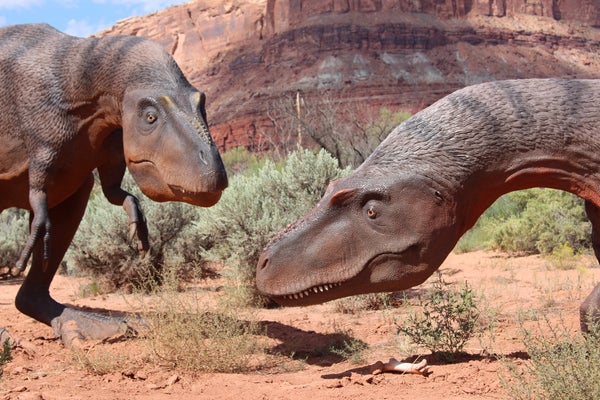This article was published in Scientific American’s former blog network and reflects the views of the author, not necessarily those of Scientific American
The social lives of prehistoric dinosaurs are almost entirely unknown to us. It’s not for lack of trying. It’s just that bones can only take us so far.
Take ornaments, for example. A crest, spike, plate, or horn could be a signal of, well, something, but precisely what generates more debate than consensus. Is that particular arrangement of horns supposed to attract mates, intimidate rivals, show membership in an age class, or all of the above? Maybe none of the above? And that’s not even getting at the difficulties in outlining the possible range of dinosaur behaviors from brain endocasts or CT scans of the cavities inside their skulls. We’re left with the constant, lingering dichotomy between what a dinosaur could do and what it actually did.
Tracks and traces take away some of that ambiguity. Really, for a dinosaur behaviorist, there’s no better record to look at. (Ichnologist Anthony Martin beautifully articulates this in his book Dinosaurs Without Bones.) A trackway isn’t hypothetical. It’s a real record of a dinosaur’s actions. And even though even the longest and best-preserved trackway can only give us a partial picture of a dinosaur's life, such traces are the best chances we have to see how dinosaurs behaved around each other. One of the most tantalizing, from a social point of view, is preserved in the roughly 75 million-year-old rock of Coahuila, Mexico.
On supporting science journalism
If you're enjoying this article, consider supporting our award-winning journalism by subscribing. By purchasing a subscription you are helping to ensure the future of impactful stories about the discoveries and ideas shaping our world today.
If you’re a diehard dinosaur fan, Coahuila should sound familiar. Fossil by fossil, paleontologist Héctor Rivera-Sylva and colleagues have been describing the Late Cretaceous dinosaurs from this part of northern Mexico and adding them to the big picture of when dinosaur evolution ran riot in western North America during the Campanian. And the record there isn’t all osteological. Rivera-Sylva and colleagues have published a new examination of a tracksite at Porvenir de Jalpa that preserves the footfalls of multiple dinosaurs, including tracks of tyrannosaurs that may have been moving together.
Paleontologists have known about this site for a while now. Back in 2007, Rodríguez de la Rosa published an analysis of the stomping ground that proposed most of the large, three-toed footprints were made by hadrosaurs. (Perhaps something like Velafrons, named from Coahuila.) But Rivera-Sylva and coauthors came to a different conclusion. Outside of a trampled portion – called the dinoturbated area – there appear to be seven closely-spaced trackways all headed in the same direction. And through additional cleaning, scanning, and study, the paleontologists concluded that these were made by large theropod dinosaurs about 26 feet long. And who were the large theropods around at this time? Tyrannosaurs.
But here’s where great care is needed. The trackways are not pristine. They've been partially-eroded from over a decade of exposure. Vandalism hasn’t helped, either. Yes, the seven trackways are evenly-spaced and move in the same direction, but whether or not the dinosaurs were there at the same time can’t be said with certainty. Given that this site was a shallow channel that various dinosaurs walked around, perhaps the parallel trackways could have been made by unaffiliated theropods strolling along a shifting tideline or animals that took similar routes along an ancient water source. In fact, there’s a hadrosaur track among the theropod prints oriented in the same direction, and it's a bit of a stretch to think that the hadrosaur was there at the exact same moment a group of tyrannosaurs ambled by. The delicate geological context – the original and intact upper bedding planes of the track surface – are gone, and so piecing together exactly what happened becomes that much more challenging.
So here’s where we test how much disbelief we’re willing to suspend. Keeping our most rigorous paleobiological standards, the seven trackways can’t be taken as proof positive of social theropods. Some of the essential geologic information is missing, and further testing of that idea will require new ideas and techniques. Nevertheless, it’s hard to look at those Campanian impressions and not see a division of theropods walking side-by-side. It’s harder to imagine one animal making a regular trip, taking care not to step in its own footprints, or several large theropods just happening to walk a body width away from the existing tracks. Even with all the necessary caveats in place, looking at these prehistoric footfalls conjures an image of tyrannosaurs flocking together.
